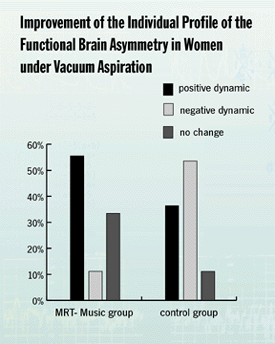- an experimental group of 19 patients at the age of 20-37, who listened to Medical Resonance Therapy Music® before, during and after the operation and did not receive any medication
- and a control group of 13 women who did not listen to MRT-Music® but were treated with spasmolytica and narcotics instead.
Medical Resonance Therapy Music®
Group
In 55,5% of the patients we could see a positive dynamic, in 11,1% a negative dynamic. In 33,4% no essential change could be observed.
The positive dynamic was predominantly characterized by the complete disappearance or by a reduction of the inversions of such coefficients of brain asymmetry, which accompany severe functional disorders and were observed by us in different forms of brain pathology.
In one woman a negative dynamic was registered where the difference in such asymmetry values increased which are responsible for a slight functional disorder.
In 55,5% of the patients we could see a positive dynamic, in 11,1% a negative dynamic. In 33,4% no essential change could be observed.
The positive dynamic was predominantly characterized by the complete disappearance or by a reduction of the inversions of such coefficients of brain asymmetry, which accompany severe functional disorders and were observed by us in different forms of brain pathology.
In one woman a negative dynamic was registered where the difference in such asymmetry values increased which are responsible for a slight functional disorder.
Control Group
In 36,4% we could see a positive dynamic, in 53,5% a negative dynamic. 11,1% women remained without essential changes. A decrease of inversions of such coefficients of brain asymmetry, which accompany severe functional disturbances and were observed by us in different forms of brain pathology, could only be registered in one woman, although also in this case no complete normalization took place.
The negative dynamic expressed in two different ways:
In 36,4% we could see a positive dynamic, in 53,5% a negative dynamic. 11,1% women remained without essential changes. A decrease of inversions of such coefficients of brain asymmetry, which accompany severe functional disturbances and were observed by us in different forms of brain pathology, could only be registered in one woman, although also in this case no complete normalization took place.
The negative dynamic expressed in two different ways:
- as inversion degeneration of the coefficients of brain asymmetry and
- as increase of differences in the asymmetry values of the brain.
Investigators:
Prof. Dr. med. W. Sidorenko
Dr. med. T. Teterkina
Dr. med. A. Fedulow
Dr. med. T. Sigalowa
Dr. med. S. Zarewa
Dr. med. Klepazkaja
Dr. med. A. Wassiljewa

